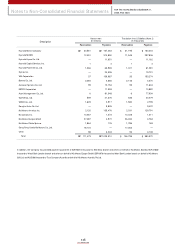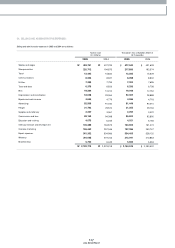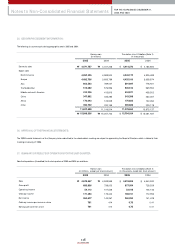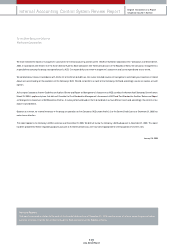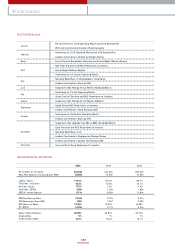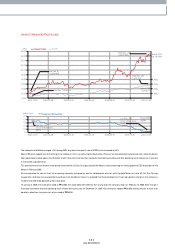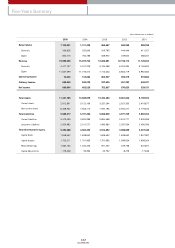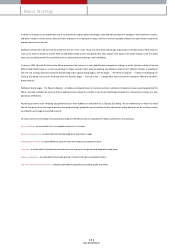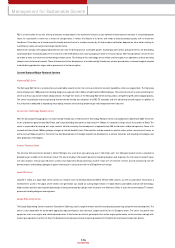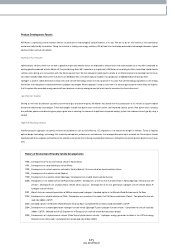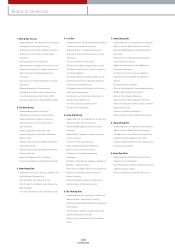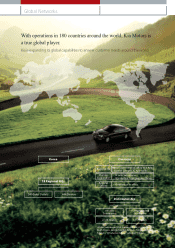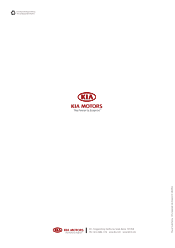Kia 2005 Annual Report Download - page 125
Download and view the complete annual report
Please find page 125 of the 2005 Kia annual report below. You can navigate through the pages in the report by either clicking on the pages listed below, or by using the keyword search tool below to find specific information within the annual report.
125
2005 Annual Report
Product Development Results
KIA Motors is operating several research centers to advance the technological com petitiveness of its cars. We aim to be on the frontier of next-generation
environm entally-friendly innovations. Taking the initiative in finding new energy solutions, KIA will continue to develop autom obile technologies based on hybrid
electric vehicles and fuel cell vehicles.
Alternative Fuel Vehicles
Hybrid electric vehicles, which run on both a gasoline engine and electric motor, are expected to reduce future fuel consumption by at least 40% com pared to
existing gasoline-pow ered vehicles. Better still, they could bring about 50% reductions in air pollutants. KIA Motors is expanding its efforts to develop hybrid electric
vehicles, and is doing so in conjunction with the Korean governm ent. We first released a hybrid electric vehicle at an official cerem ony for developm ent of future
cars held in October 2004. With further investm ents of 300 billion Won, we w ill be ready to establish m ass production of 300,000 hybrid vehicles by 2010.
Hydrogen is another viable alternative to fossil fuels. And fuel cell technology shows the most prom ise in this area. Fuel cell technology capitalizes on the energy
conversion that takes place in reactions betw een hydrogen and oxygen. When hydrogen is used as fuel, there is no exhaust gas except for water. Many are hopeful
that this potentially renewable energy source will soon becom e a m ainstay energy source that ends harm ful em issions into the environm ent.
Low-Pollution Vehicles
Striving to m inim ize air pollution caused by conventional gas and diesel engines, KIA Motors has altered the mass production of its vehicles to accommodate
environm entally-friendly technologies. These technologies include new pow er train & exhaust system , and improved catalyst system . New pow er train, including
low-pollution gasoline and diesel engines, plays a great role in reducing the release of air pollutants. Improved catalyst system , too, reduces exhaust gas by using a
catalyst.
High Fuel Efficiency Vehicles
Another proactive approach to tacking environm ental problem s such as fuel efficiency, CO2regulations is to reduce the weight of vehicles. To do so requires
optimal design technology, technology that m aximizes com ponent perform ance, and advances that leverage alternative input materials, etc. Fewer inputs should
hopefully lead to less negative externalities to the econom y and environment during car production processes. And lighter cars would presum ably burn less fuel as
well.
History of Environment-Friendly Vehicle Developments
1986 _ Developm ent of the first ever electric vehicle in Korea (Vesta)
1991 _ Developm ent of a lead cell electric vehicle (Pride)
1993 _ Developm ent of a nickel-cadmium cell electric Vehicle (Sephia) / First ever sale of an electric vehicle in Korea
1995 _ Developm ent of an electric vehicle (Sephia)
1999 _ Developm ent of an electric vehicle (Sportage) / Developm ent of a hybrid electric vehicle (Avante)
2000 _ Participation in the California Fuel-Cell Partnership (CaFCP) / Developm ent of the first ever fuel cell vehicle in Korea (Sportage methanol fuel cell
vehicle) / Developm ent of a hybrid electric vehicle (Verna, County) / Developm ent of the first generation hydrogen fuel cell vehicle (Santa Fe
hydrogen fuel cell vehicle)
2001 _ World’s first ever successful generation of 350 bar com pressed hydrogen / Awarded a prize in the Michelin World Environm ental Car Race
2002 _ Developm ent of a hybrid electric car (Click) / Participation as a m em ber of the Japan Fuel Cell Com mercialization Project / Completed the fuel cell
road rally (480km , CaFCP)
2003 _ Awarded a prize in the Michelin World Environm ental Car Race / Com pleted the fuel cell car road rally (640km , CaFCP)
2004 _ Developm ent of a second generation hydrogen fuel cell vehicle (Sportage/ Tucson hydrogen fuel cell vehicle) / Com pleted the fuel cell road rally
(208km , CaFCP) / Selected by the U.S. Department of Energy to run a fuel cell vehicle dem onstration project
2005 _ Developm ent of a hybrid electric vehicle (Pride/ Verna hybrid electric vehicle) / Hydrogen energy generator installed in the US Technology
Research center (Chino Lab) / Com pleted the fuel cell road rally (410km , EVS21)



